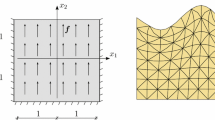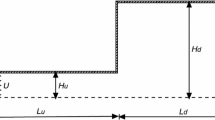Appendix 1
The coefficient matrices in the discretized governing Eq. (4) are given by
$$ \begin{aligned} {\mathbf{M}}_{u} & = \int\limits_{\Upomega } {{\mathbf{N}}_{u}^{\text{T}} \rho {\mathbf{N}}_{u} {\text{d}}\Upomega } \\ {\mathbf{M}}_{w} & = \int\limits_{\Upomega } {\nabla {\mathbf{N}}_{{p_{w} }}^{{ {\text{T}}}} \varvec{ }\rho_{w} \left( {{\mathbf{k}}/\mu_{w} } \right){\mathbf{N}}_{u} {\text{d}}\Upomega } \\ {\mathbf{Q}} & = \int\limits_{\Upomega } {{\mathbf{B}}^{\text{T}} \alpha {\mathbf{m}} {\mathbf{N}}_{{p_{w} }} {\text{d}}\Upomega } \\ {\mathbf{C}} & = \int\limits_{\Upomega } {{\mathbf{N}}_{{p_{w} }}^{\text{T}} \left( {\frac{\alpha - n}{{K_{\text{s}} }} + \frac{n}{{K_{w} }}} \right){\mathbf{N}}_{{p_{w} }} {\text{d}}\Upomega } \\ {\mathbf{H}} & = \int\limits_{\Upomega } {\nabla {\mathbf{N}}_{{p_{w} }}^{{ {\text{T}}}} \left( {{\mathbf{k}}/\mu_{w} } \right)\nabla {\mathbf{N}}_{{p_{w} }} {\text{d}}\Upomega } \\ \end{aligned} $$
(42)
and the external force and flux vectors are given by
$$ \begin{aligned} {\mathbf{F}}_{u} & = \int\limits_{\Upomega } {{\mathbf{N}}_{u}^{\text{T}} \rho {\mathbf{b}}\,{\text{d}}\Upomega } + \int\limits_{{\Upgamma _{t} }} {{\mathbf{N}}_{u}^{\text{T}} {\bar{\mathbf{t}}} {\text{d}}\Upgamma } \\ {\mathbf{F}}_{w} & = \int\limits_{\Upomega } {\nabla {\mathbf{N}}_{{p_{w} }}^{\text{T}} \rho_{w} \left( {{\mathbf{k}}/\mu_{w} } \right){\mathbf{b}} {\text{d}}\Upomega } - \int\limits_{{\Upgamma _{{q_{w} }} }} {{\mathbf{N}}_{{p_{w} }}^{\text{T}} \bar{q}_{w} {\text{d}}\Upgamma } \\ \end{aligned} $$
(43)
where m is the identity vector defined as \( {\mathbf{m}} = \left[ {\begin{array}{*{20}c} 1 & 1 & 1 & 0 & 0 & 0 \\ \end{array} } \right]^{\text{T}} ,\,{\bar{\mathbf{t}}} \) is the prescribed traction imposed on boundary \( \Upgamma _{t} \) and \( \bar{q}_{w} \) is the prescribed outflow imposed on the permeable boundary \( \Upgamma _{{q_{w} }} . \)
Appendix 2
The components of the local Jacobian matrix \( {\mathbf{J}}^{i} \) are given by
$$ \begin{aligned} \partial {\mathbf{r}}_{{\varepsilon^{e} }}^{i}
/\partial {\varvec{\upvarepsilon}}^{e,i} & = {\bf 1} + \Updelta L^{i}
\partial {\mathbf{R}}^{i} /\partial {\varvec{\upvarepsilon}}^{e,i}
\\ \partial {\mathbf{r}}_{{\varepsilon^{e} }}^{i} /\partial
{\varvec{\upalpha}}^{i} & =\Updelta L^{i} \partial {\mathbf{R}}^{i}
/\partial {\varvec{\upalpha}}^{i} \\ \partial
{\mathbf{r}}_{{\varepsilon^{e} }}^{i} /\partial {\mathbf{z}}^{i} &
=\Updelta L^{i} \partial {\mathbf{R}}^{i} /\partial {\mathbf{z}}^{i}
\\ \partial {\mathbf{r}}_{{\varepsilon^{e} }}^{i} /\partial\Updelta L^{i} & = {\mathbf{R}}^{i} \\ \partial {\mathbf{r}}_{\alpha }^{i}
/\partial {\varvec{\upvarepsilon}}^{e,i} & = -\Updelta L^{i} \left(
{2/3} \right)\left( {{\mathbf{b}}^{i}\otimes \partial h^{i}
/\partial {\varvec{\upvarepsilon}}^{e,i} + h^{i} \partial
{\mathbf{b}}^{i} /\partial {\varvec{\upvarepsilon}}^{e,i} } \right)
\\ \partial {\mathbf{r}}_{\alpha }^{i} /\partial
{\varvec{\upalpha}}^{i} & = {\bf 1} -\Updelta L^{i} \left( {2/3}
\right)\left( {{\mathbf{b}}^{i}\otimes \partial h^{i} /\partial
{\varvec{\upalpha}}^{i} + h^{i} \partial {\mathbf{b}}^{i} /\partial
{\varvec{\upalpha}}^{i} } \right) \\ \partial {\mathbf{r}}_{\alpha
}^{i} /\partial {\mathbf{z}}^{i} & = {\bf 0} \\ \partial
{\mathbf{r}}_{\alpha }^{i} /\partial\Updelta L^{i} & = - \left(
{2/3} \right)h^{i} {\mathbf{b}}^{i} \\ \partial {\mathbf{r}}_{z}^{i}
/\partial {\varvec{\upvarepsilon}}^{e,i} & = c_{z}\Updelta L^{i}
\left( { - H\left( { - D^{i} } \right)\left( {z_{ {\rm max} }
{\mathbf{n}}^{i} + {\mathbf{z}}^{i} } \right)\otimes \partial D^{i}
/\partial {\varvec{\upvarepsilon}}^{e,i} + \langle- D^{i}\rangle \varvec{ }z_{
{\rm max} } \partial {\mathbf{n}}^{i} /\partial
{\varvec{\upvarepsilon}}^{e,i} } \right) \\ \partial
{\mathbf{r}}_{z}^{i} /\partial {\varvec{\upalpha}}^{i} & =
c_{z}\Updelta L^{i} \left( { - H\left( { - D^{i} } \right)\left(
{z_{ {\rm max} } {\mathbf{n}}^{i} + {\mathbf{z}}^{i} }
\right)\otimes \partial D^{i} /\partial {\varvec{\upalpha}}^{i} + \langle-
D^{i}\rangle \varvec{ }z_{ {\rm max} } \partial {\mathbf{n}}^{i} /\partial
{\varvec{\upalpha}}^{i} } \right) \\ \partial {\mathbf{r}}_{z}^{i}
/\partial {\mathbf{z}}^{i} & = {\bf 1} + c_{z}\Updelta L^{i} \left( { -
H\left( { - D^{i} } \right)\left( {z_{ {\rm max} } {\mathbf{n}}^{i}
+ {\mathbf{z}}^{i} } \right)\otimes \partial D^{i} /\partial
{\mathbf{z}}^{i} + \langle- D^{i}\rangle \varvec{ }{\bf 1}} \right) \\ \partial
{\mathbf{r}}_{z}^{i} /\partial\Updelta L^{i} & = c_{z} \langle- D^{i}\rangle
\left( {z_{ {\rm max} } {\mathbf{n}}^{i} + {\mathbf{z}}^{i} }
\right) \\ \partial {\text{r}}_{{\Updelta L}}^{i} /\partial
{\varvec{\upvarepsilon}}^{e,i} & = {\mathbf{n}}^{i}\cdot \partial
{\mathbf{s}}^{i} /\partial {\varvec{\upvarepsilon}}^{e,i} - \left(
{{\varvec{\upalpha}}^{i}\cdot {\mathbf{n}}^{i} + \sqrt {2/3} m}
\right)\partial p^{i} /\partial {\varvec{\upvarepsilon}}^{e,i} \\
\partial {\text{r}}_{{\Updelta L}}^{i} /\partial
{\varvec{\upalpha}}^{i} & = - p^{i} {\mathbf{n}}^{i} \\ \partial
{\text{r}}_{{\Updelta L}}^{i} /\partial {\mathbf{z}}^{i} & = {\bf 0}
\\ \partial {\text{r}}_{{\Updelta L}}^{i} /\partial\Updelta L^{i} &
= 0 \\ \end{aligned} $$
(44)
in which
$$ \begin{aligned} \partial {\mathbf{R}}^{i} /\partial
{\varvec{\upvarepsilon}}^{e,i} & = {\mathbf{n}}^{i} \otimes
\partial B^{i} /\partial {\varvec{\upvarepsilon}}^{e,i} + B^{i}
\partial {\mathbf{n}}^{i} /\partial {\varvec{\upvarepsilon}}^{e,i} +
\left( {\left( {{\mathbf{n}}^{i} } \right)^{2} - \left( {1/3}
\right){\mathbf{m}}} \right) \otimes \partial C^{i} /\partial
{\varvec{\upvarepsilon}}^{e,i} + 2C^{i} {\mathbf{n}}^{i} \\ &
\quad \cdot \partial {\mathbf{n}}^{i} /\partial
{\varvec{\upvarepsilon}}^{e,i} - \left( {1/3} \right){\mathbf{m}}
\otimes \partial D^{i} /\partial {\varvec{\upvarepsilon}}^{e,i} \\
\partial {\mathbf{R}}^{i} /\partial {\varvec{\upalpha}}^{i} & =
{\mathbf{n}}^{i} \otimes \partial B^{i} /\partial
{\varvec{\upalpha}}^{i} + B^{i} \partial {\mathbf{n}}^{i} /\partial
{\varvec{\upalpha}}^{i} + \left( {\left( {{\mathbf{n}}^{i} }
\right)^{2} - \left( {1/3} \right){\mathbf{m}}} \right) \otimes
\partial C^{i} /\partial {\varvec{\upalpha}}^{i} + 2C^{i}
{\mathbf{n}}^{i} \\ & \quad \cdot \partial {\mathbf{n}}^{i}
/\partial {\varvec{\upalpha}}^{i} - \left( {1/3} \right){\mathbf{m}}
\otimes \partial D^{i} /\partial {\varvec{\upalpha}}^{i} \\ \partial
{\mathbf{R}}^{i} /\partial {\mathbf{z}}^{i} & = - \left( {1/3}
\right){\mathbf{m}} \otimes \partial D^{i} /\partial
{\mathbf{z}}^{i} \\ \partial h^{i} /\partial
{\varvec{\upvarepsilon}}^{e,i} & = h^{i} \left( {\partial
{b_{0}^{i}} /\partial {\varvec{\upvarepsilon}}^{e,i} - h^{i} \left(
{{\varvec{\upalpha}}^{i} - {\varvec{\upalpha}}_{\text{in}} } \right)
\cdot \partial {\mathbf{n}}^{i} /\partial
{\varvec{\upvarepsilon}}^{e,i} } \right)/b_{0}^{i} \\ \partial h^{i}
/\partial {\varvec{\upalpha}}^{i} & = - \left( {h^{i} }
\right)^{2} \left( {{\mathbf{n}}^{i} + \left(
{{\varvec{\upalpha}}^{i} - {\varvec{\upalpha}}_{\text{in}} } \right)
\cdot \partial {\mathbf{n}}^{i} /\partial {\varvec{\upalpha}}^{i}
} \right)/b_{0}^{i} \\ \partial {\mathbf{b}}^{i} /\partial
{\varvec{\upvarepsilon}}^{e,i} & = \sqrt {2/3} \left(
{{\mathbf{n}}^{i} \otimes \partial \alpha_{\theta }^{b,i} /\partial
{\varvec{\upvarepsilon}}^{e,i} + \alpha_{\theta }^{b,i} \partial
{\mathbf{n}}^{i} /\partial {\varvec{\upvarepsilon}}^{e,i} } \right)
\\ \partial {\mathbf{b}}^{i} /\partial {\varvec{\upalpha}}^{i} &
= \sqrt {2/3} \left( {{\mathbf{n}}^{i} \otimes \partial
\alpha_{\theta }^{b,i} /\partial {\varvec{\upalpha}}^{i} +
\alpha_{\theta }^{b,i} \partial {\mathbf{n}}^{i} /\partial
{\varvec{\upalpha}}^{i} } \right) - {\bf 1} \\ \partial D^{i} /\partial
{\varvec{\upvarepsilon}}^{e,i} & = \left( {A_{0} H\left(
{{\mathbf{z}}^{i} \cdot {\mathbf{n}}^{i} } \right)\left(
{{\mathbf{d}}^{i} \cdot {\mathbf{n}}^{i} } \right)\varvec{
}{\mathbf{z}}^{i} - A_{d}^{i} {\varvec{\upalpha}}^{i} } \right)
\cdot \partial {\mathbf{n}}^{i} /\partial
{\varvec{\upvarepsilon}}^{e,i} + \sqrt {2/3} A_{d}^{i} \partial
\alpha_{\theta }^{d,i} /\partial {\varvec{\upvarepsilon}}^{e,i} \\
\partial D^{i} /\partial {\varvec{\upalpha}}^{i} & = \left(
{A_{0} H\left( {{\mathbf{z}}^{i} \cdot {\mathbf{n}}^{i} }
\right)\left( {{\mathbf{d}}^{i} \cdot {\mathbf{n}}^{i} }
\right)\varvec{ }{\mathbf{z}}^{i} - A_{d}^{i}
{\varvec{\upalpha}}^{i} } \right) \cdot \partial {\mathbf{n}}^{i}
/\partial {\varvec{\upalpha}}^{i} + A_{d}^{i} \left( {\sqrt {2/3}
\partial \alpha_{\theta }^{d,i} /\partial {\varvec{\upalpha}}^{i} -
{\mathbf{n}}^{i} } \right) \\ \partial D^{i} /\partial
{\mathbf{z}}^{i} & = A_{0} H\left( {{\mathbf{z}}^{i} \cdot
{\mathbf{n}}^{i} } \right)\left( {{\mathbf{d}}^{i} \cdot
{\mathbf{n}}^{i} } \right)\varvec{ }{\mathbf{n}}^{i} \\ \partial
{\mathbf{n}}^{i} /\partial {\varvec{\upvarepsilon}}^{e,i} & =
\left( {\partial {\mathbf{s}}^{i} /\partial
{\varvec{\upvarepsilon}}^{e,i} - {\varvec{\upalpha}}^{i} \otimes
\partial p^{i} /\partial {\varvec{\upvarepsilon}}^{e,i} -
{\mathbf{n}}^{i} \otimes \left( {{\mathbf{n}}^{i} \cdot \partial
{\mathbf{s}}^{i} /\partial {\varvec{\upvarepsilon}}^{e,i} - \left(
{{\varvec{\upalpha}}^{i} \cdot {\mathbf{n}}^{i} } \right)\partial
{p^{i}} /\partial {\varvec{\upvarepsilon}}^{e,i} } \right)}
\right)\varvec{ }/\left| {{\mathbf{s}}^{i} - p^{i}
{\varvec{\upalpha}}^{i} } \right| \\ \partial {\mathbf{n}}^{i}
/\partial {\varvec{\upalpha}}^{i} & = - p^{i} \left( {{\bf 1} -
{\mathbf{n}}^{i} \otimes {\mathbf{n}}^{i} } \right)/\left|
{{\mathbf{s}}^{i} - p^{i} {\varvec{\upalpha}}^{i} } \right| \\
\partial p^{i} /\partial {\varvec{\upvarepsilon}}^{e,i} & = -
{{K}}^{i} {\mathbf{m}} \\ \partial
{\mathbf{s}}^{i} /\partial {\varvec{\upvarepsilon}}^{e,i} & = -
{{K}}^{i} /\left( {2p^{i} } \right)\Updelta {\mathbf{s}}^{i}
\otimes{\mathbf{m}} + 2{{G}}^{i} \left( {{\bf 1} - \left( {1/3}
\right){\mathbf{m}} \otimes {\mathbf{m}}} \right) \\ \end{aligned}
$$
(45)
where \( {\mathbf{1}} \) is the 6 × 6 identity matrix, H is the Heaviside step function whose value is unity for positive arguments and zero otherwise, the symbol ǀ ǀ denotes the \( L_{2} \) norm of a vector, and the symbol \( \otimes \) denotes the dyadic product of two vectors.
Appendix 3
The components of \( \partial {\mathbf{r}}/\partial {\varvec{\upvarepsilon}} \) are given by
$$ \begin{aligned} \partial {\mathbf{r}}_{{\varepsilon^{e} }} /\partial {\varvec{\upvarepsilon}} & = - {\bf 1} +\Updelta L\partial {\mathbf{R}}/\partial {\varvec{\upvarepsilon}} \\ \partial {\mathbf{r}}_{\alpha } /\partial {\varvec{\upvarepsilon}} & = -\Updelta L\left( {2/3} \right)\left( {{\mathbf{b}} \otimes \partial h/\partial {\varvec{\upvarepsilon}} + h\,\partial {\mathbf{b}}/\partial {\varvec{\upvarepsilon}}} \right) \\ \partial {\mathbf{r}}_{z} /\partial {\varvec{\upvarepsilon}} & = c_{z}\Updelta L\left( { - H\left( { - D} \right)\left( {z_{ \hbox{max} } {\mathbf{n}} + {\mathbf{z}}} \right) \otimes \partial D/\partial {\varvec{\upvarepsilon}} + \langle - D\rangle \varvec{ }z_{ \hbox{max} } \partial {\mathbf{n}}/\partial {\varvec{\upvarepsilon}}} \right) \\ \partial {\text{r}}_{{\Updelta L}} /\partial {\varvec{\upvarepsilon}} & = {\mathbf{n}} \cdot \partial {\mathbf{s}}/\partial {\varvec{\upvarepsilon}} - \left( {{\varvec{\upalpha}} \cdot {\mathbf{n}} + \sqrt {2/3} m} \right)\partial p/\partial {\varvec{\upvarepsilon}} \\ \end{aligned} $$
(46)
in which
$$ \begin{aligned} \partial {\mathbf{R}}/\partial {\varvec{\upvarepsilon}} & = {\mathbf{n}} \otimes \partial B/\partial {\varvec{\upvarepsilon}} + B\,\partial {\mathbf{n}}/\partial {\varvec{\upvarepsilon}} + \left( {{\mathbf{n}}^{2} - \left( {1/3} \right){\mathbf{m}}} \right) \otimes \partial C/\partial {\varvec{\upvarepsilon}} + 2C{\mathbf{n}} \cdot \partial {\mathbf{n}}/\partial {\varvec{\upvarepsilon}} - \left( {1/3} \right){\mathbf{m}} \otimes \partial D/\partial {\varvec{\upvarepsilon}} \\ \partial h/\partial {\varvec{\upvarepsilon}} & = h\left( {\partial b_{0} /\partial {\varvec{\upvarepsilon}} - h\left( {{\varvec{\upalpha}} - {\varvec{\upalpha}}_{\text{in}} } \right) \cdot \partial {\mathbf{n}}/\partial {\varvec{\upvarepsilon}}} \right)/b_{0} \\ \partial {\mathbf{b}}/\partial {\varvec{\upvarepsilon}} & = \sqrt {2/3} \left( {{\mathbf{n}} \otimes \partial \alpha_{\theta }^{b} /\partial {\varvec{\upvarepsilon}} + \alpha_{\theta }^{b} \partial {\mathbf{n}}/\partial {\varvec{\upvarepsilon}}} \right) \\ \partial D/\partial {\varvec{\upvarepsilon}} & = \left( {A_{0} H\left( {{\mathbf{z}} \cdot {\mathbf{n}}} \right)\left( {{\mathbf{d}} \cdot {\mathbf{n}}} \right)\varvec{ }{\mathbf{z}} - A_{d} {\varvec{\upalpha}}} \right) \cdot \partial {\mathbf{n}}/\partial {\varvec{\upvarepsilon}} + \sqrt {2/3} A_{d} \partial \alpha_{\theta }^{d} /\partial {\varvec{\upvarepsilon}} \\ \partial {\mathbf{n}}/\partial {\varvec{\upvarepsilon}} & = \left( {\partial {\mathbf{s}}/\partial {\varvec{\upvarepsilon}} - {\varvec{\upalpha}} \otimes \partial p/\partial {\varvec{\upvarepsilon}} - {\mathbf{n}} \otimes \left( {{\mathbf{n}} \cdot \partial {\mathbf{s}}/\partial {\varvec{\upvarepsilon}} - \left( {{\varvec{\upalpha}} \cdot {\mathbf{n}}} \right)\partial p/\partial {\varvec{\upvarepsilon}}} \right)} \right)/\left| {{\mathbf{s}} - p{\varvec{\upalpha}}} \right| \\ \partial p/\partial {\varvec{\upvarepsilon}} & = \left( {4.97 + e} \right)/\left( {2.97 - e} \right){{K}}\Updelta \varepsilon_{\text{v}}^{e} {\mathbf{m}} \\ \partial {\mathbf{s}}/\partial {\varvec{\upvarepsilon}} & = \left( {4.97 + e} \right)/\left( {2.97 - e} \right)\left( { - 1 + {{K}}\Updelta \varepsilon_{\text{v}}^{e} /\left( {2p} \right)} \right)\Updelta {\mathbf{s}} \otimes {\mathbf{m}} \\ \end{aligned} $$
(47)












